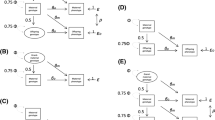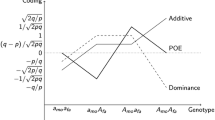Abstract
Genome wide complex trait analysis (GCTA) is extended to include environmental effects of the maternal genotype on offspring phenotype (“maternal effects”, M-GCTA). The model includes parameters for the direct effects of the offspring genotype, maternal effects and the covariance between direct and maternal effects. Analysis of simulated data, conducted in OpenMx, confirmed that model parameters could be recovered by full information maximum likelihood (FIML) and evaluated the biases that arise in conventional GCTA when indirect genetic effects are ignored. Estimates derived from FIML in OpenMx showed very close agreement to those obtained by restricted maximum likelihood using the published algorithm for GCTA. The method was also applied to illustrative perinatal phenotypes from ~4,000 mother-offspring pairs from the Avon Longitudinal Study of Parents and Children. The relative merits of extended GCTA in contrast to quantitative genetic approaches based on analyzing the phenotypic covariance structure of kinships are considered.


Similar content being viewed by others
References
Boker SM, Neale MC, Maes HH, Wilde MJ, Spiegel M, Timothy R, Brick TR, Spies J, Estabrook R, Kenny S, Bates TC, Mehta P, Fox J (2011) OpenMx: an open source extended structural equation modeling framework. Psychometrika 76:306–317
Boker SM, Neale MC, Maes HH, Wilde MJ, Spiegel M, Timothy R, Brick TR, Spies J, Estabrook R, Bates TC, Mehta P, Fox J, von Oertzen T, Gore RJ, Hunter MD, Hackett DC, Karch J, Brandmaier AM (2012) OpenMx 999.0 User Guide
Boyd A, Golding J, Macleod J, Lawlor DA, Fraser A, Henderson J, Molloy L, Ness A, Ring S, Davey Smith G (2013) Cohort profile: the ‘children of the 90s’–the index offspring of the Avon Longitudinal Study of Parents and Children. Int J Epidemiol 42:111–127
Cavalli-Sforza LL, Feldman MW (1973) Cultural versus biological inheritance: phenotypic transmission from parents to children. (A theory of the effect of parental phenotypes on children’s phenotypes). Am J Hum Genet 25:618–637
Cloninger CR, Rice J, Reich T (1979) Multifactorial inheritance with cultural transmission and assortative mating. II. a general model of combined polygenic and cultural inheritance. Am J Hum Genet 31:176–198
Corey LA, Nance WE (1978) The monozygotic half-sib model: a tool for epidemiologic research. Prog Clin Biol Res 24A:201–209
Dawkins R (1989) The extended phenotype. Oxford University Press, Oxford
Eaves LJ (1976) A model for sibling effects in man. Heredity 36:205–214
Evans DM, Zhu G, Dy V, Heath AC, Madden PA, Kemp JP, McMahon G, St Pourcain B, Timpson NJ, Golding J, Lawlor DA, Steer C, Montgomery GW, Martin NG, Smith GD, Whitfield JB (2013) Genome-wide association study identifies loci affecting blood copper, selenium and zinc. Hum Mol Genet 22:3807–3817
Falconer DS, McKay TFC (1996) Introduction to quantitative genetics, 4th edn. Pearson Education, Harlow
Fatemifar G, Hoggart CJ, Paternoster L, Kemp JP, Prokopenko I, Horikoshi M, Wright VJ, Tobias JH, Richmond S, Zhurov AI, Toma AM, Pouta A, Taanila A, Sipila K, Lähdesmäki R, Pillas D, Geller F, Feenstra B, Melbye M, Nohr EA, Ring SM, St Pourcain B, Timpson NJ, Davey Smith G, Jarvelin MR, Evans DM (2013) Genome-wide association study of primary tooth eruption identifies pleiotropic loci associated with height and craniofacial distances. Hum Mol Genet 22:3807–3817
Fisher RA (1918) The correlation between relatives on the supposition of Mendelian inheritance. Philol Trans Roy Soc Edinb 52:399–433
Fraser A, Macdonald-Wallis C, Tilling K, Boyd A, Golding J, Davey Smith G, Henderson J, Macleod J, Molloy L, Ness A, Ring S, Nelson SM, Lawlor DA (2013) Cohort profile: the Avon Longitudinal Study of Parents and Children: ALSPAC mothers cohort. Int J Epidemiol 42:97–110
Haley CS, Jinks JL, Last K (1981) The monozygotic twin half-sib method for analysing maternal effects and sex-linkage in humans. Heredity 46:227–238
Mather K, Jinks JL (1982) Biometrical genetics: the study of continuous variation, 3rd edn. Chapman-Hall, London
Meyer K (1989) Restricted maximum likelihood to estimate variance components for animal models with several random effects using a derivative-free algorithm. Genet Sci Evol 21:317–340
Truett KR, Eaves LJ, Walters EE, Heath AC, Hewitt JK, Meyer JM, Silberg J, Neale MC, Martin NG, Kendler KS (1994) A model system for analysis of family resemblance in extended kinships of twins. Behav Genet 24:35–49
Trzaskowski M, Davis OS, Defries JC, Yang J, Visscher PM, Plomin R (2013) DNA evidence for strong genome-wide pleiotropy of cognitive and learning abilities. Behav Genet 43:267–273
Wright S (1921) Correlation and Causation. J Agr Res 20:557–585
Yang J, Benjamin B, McEvoy BP, Gordon S, Henders AK, Nyholt DR, Madden PA, Heath AC, Martin NG, Montgomery GW, Goddard ME, Visscher PM (2010) Common SNPs explain a large proportion of the heritability for human height. Nat Genet 42:565–569
Yang JS, Lee H, Goddard ME, Visscher PM (2011a) GCTA: a Tool for genome-wide complex trait analysis. Am J Hum Genet 88:76–82
Yang J, Manolio TA, Pasquale LR, Boerwinkle E, Caporaso N, Cunningham JM, de Andrade M, Feenstra B, Feingold E, Hayes MG, Hill WG, Landi MT, Alonso A, Lettre G, Lin P, Ling H, Lowe W, Mathias RA, Melbye M, Pugh E, Cornelis MC, Weir BS, Goddard ME, Visscher PM (2011b) Genome partitioning of genetic variation for complex traits using common SNPs. Nat Genet 43:519–525
York TP, Strauss JF 3rd, Neale MC, Eaves LJ (2009) Estimating fetal and maternal genetic contributions to premature birth from multiparous pregnancy histories of twins using MCMC and maximum-likelihood approaches. Twin Res Hum Genet 12:333–342
York TP, Strauss JF 3rd, Neale MC, Eaves LJ (2010) Racial differences in genetic and environmental risk to preterm birth. PLoS One 5(8):e12391
York TP, Eaves LJ, Lichtenstein P, Neale MC, Svensson A, Latendresse S, Långström N, Strauss JF 3rd (2013) Fetal and maternal genes’ influence on gestational age in a quantitative genetic analysis of 244,000 swedish births. Am J Epidemiol 178:543–550
Acknowledgments
This work was partly conducted in the Medical Research Council Integrative Epidemiology Unit, a research unit supported by the Medical Research Council (MC_UU_12013 to GDS). The study was supported by a Benjamin Meaker visiting professorship at the University of Bristol Institute for Advanced Studies, UK (LJE), an Australian Research Council Future Fellowship (FT130101709, DME), a Medical Research Council Programme Grant (MC_UU_12013/4, DME), National Institute of Health grants P60MD002256 (York, Eaves) and R01AA018333 (Eaves, York) and an Autism Speaks grant (7132,BStP). We thank Peter Visscher and Matthew Robinson for insightful comments on an earlier draft of this paper. We are extremely grateful to all the families who took part in the study, the midwives for their help in recruiting them, and the whole ALSPAC team, which includes interviewers, computer and laboratory technicians, clerical workers, research scientists, volunteers, managers, receptionists and nurses. The UK Medical Research Council and the Wellcome Trust (Grant ref: 092731) and the University of Bristol provide core support for ALSPAC. This publication is the work of the authors and D.M.E will serve as guarantor for the contents of this paper.
Author information
Authors and Affiliations
Corresponding author
Additional information
Edited by Sarah Medland.
Rights and permissions
About this article
Cite this article
Eaves, L.J., Pourcain, B.S., Smith, G.D. et al. Resolving the Effects of Maternal and Offspring Genotype on Dyadic Outcomes in Genome Wide Complex Trait Analysis (“M-GCTA”). Behav Genet 44, 445–455 (2014). https://doi.org/10.1007/s10519-014-9666-6
Received:
Accepted:
Published:
Issue Date:
DOI: https://doi.org/10.1007/s10519-014-9666-6




